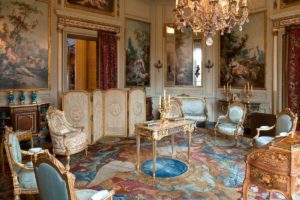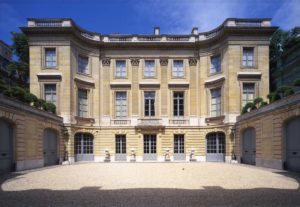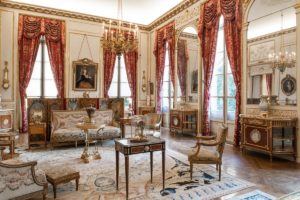Off the Beaten Path in Paris
Located in the northern reaches of Paris’ 8th Arrondissement, tucked against the beautiful Parc Monceau, sits the Nissim de Camondo Museum, which holds the city’s most significant decorative arts collection outside of the Louvre. Even aficionados of the antique rarely reach this out-of-the-way destination, which should be on your must-see list for your next sojourn in the City of Lights. Think of the trek as a pilgrimage to a diminutive Winterthur for 18th-century French material culture.
The house and collection represent decades of assiduous acquisitions and efforts by Moïse de Camondo. While not as famous as their Rothschild contemporaries, the Camondos were powerful financiers of Sephardic Jewish origin who found refuge in the Ottoman Empire during the Spanish Inquisition. From roots in Constantinople, family members established connections in Vienna, London, and Paris.
Moïse was the second generation to live on the Rue de Monceau, rebuilding his father’s mansion from 1911–14 with the assistance of society architect René Sergent. Largely inspired by the Petit Trianon, the house was envisioned as a gallery for an impressive collection, which Camondo began in the 1890s, focusing on the highest quality French 18th-century decorative art, particularly the transitional style that connected rococo and neoclassical design. Moïse carefully recorded each purchase from 1907 onward in a special book, a tremendous resource for historians of early-20th-century collecting.
The interiors of the Camondo mansion are truly stunning, with period boiserie, tapestries, paintings, and hard and soft furnishings tastefully arranged within Sergent’s sympathetic architectural framework. A set of seating furniture by George Jacob covered in Aubusson tapestry holds court in the Grand Salon along with a handsome portrait of Le Couteulx du Molay by Vigeé-Lebrun (1788) and a gilt and blue-bronze chandelier once owned by Napoleon. A salon with pastoral scenes by Jean-Baptiste Huet is reminiscent of the Frick’s Fragonard Room yet features a more impressive collection of objects.
While the grandeur of the museum is spellbinding, the fate of the Camondo family is heartbreaking. Married in 1891 to Irène Cahen d’Anvers, the daughter of another powerful Jewish financier, the couple had two children before a bitter and public divorce in 1902. Their son, Nissim, the museum’s namesake, was killed in 1917 while piloting a reconnaissance mission during World War I. This loss led Moïse to bequeath the house and collection to the French people following his death in 1935. His only surviving heir, a daughter, Béatrice, was arrested by the Nazis in 1942 along with her husband and two children, none of whom returned from Auschwitz.
Rarely do sites intertwine beauty and tragedy to such an incredible degree, which is why a lengthy visit to the Camondo Museum will provide a powerful experience not soon forgotten.



